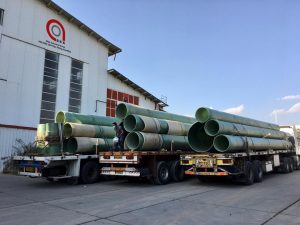From the 1960s composite pipes were also used in water and waste water applications.
Today composite pipes are available in a variety of sizes and pressure ranges:
Diameter:25mm-4000mm
Pressure:1bar- 233(3380ppi)
The increase in application of composite pipes is due to some advantages that these pipes have in comparison to steel pipes, ductile iron pipes and concrete pipes. Some of these advantages include
High chemical resistance
Higher mechanical strength compared to polyethylene products.
Low weight (approximately only 25%n weight of steel pipes)
Resistance against corrosion and oxidation.
Ease of installation. No requirement of heavy duty equipment and machinery for installation.
Resistance against heat. If required heat resistance for temperatures above 130°C.
Smooth inner surface.
50year lifetime.
Approved for potable water usage.
UV resistance.
Resistance against fire.
Electric and thermal insulator.
Stability of hydraulic parameters during operational phase
GRE pipes and fitting are considered composite products used for high pressure applications which are commonly used in oil and gas industry, these pipes are made of glass fiber and epoxy resin. Behest Keir Ariana Industrial Group supplies its GRE products under the brand name of FLOXY®.
With FLOXY®, BKA CO offers the world’s most comprehensive line of Glass Fiber Reinforced Epoxy (GRE) pipe products, representing a cost-effective alternative to corrosion-prone metallic piping and (reinforced) thermos plastic. The corrosion resistance and chemical inertness of Glass Fiber Reinforced Epoxy (GRE) pipe make it especially suitable for service in hostile and corrosive environments. Furthermore, it is much lighter in weight than comparable steel pipe and easier to install.

resistance against water and saltwater for production of GRP pipes mainly used in water and waste water applications.
resistance against water, salt water, acids and bases
For production of GRV pipes mainly used in chemical and petrochemical industry
resistance against water, salt water, solvent and bases
For production of GRE pipes mainly used in oil and gas industry
In general, for comparing physical, mechanical and chemical properties the following relation is true
Fiber Reinforced Plastic
Glass fiber Reinforced Plastic
Glass fiber Reinforced Vinylester
Glass Reinforced Epoxy
Carbon Fiber Reinforced Plastic
Glass fiber Reinforced Epoxy
Pipe system
Glass Reinforced Epoxy (GRE) materials are an alternative to carbon steel pipes which are highly useful especially for corrosive, Aggressive and normal environments.
High strength fiberglass and amine cured epoxy resin processed under discontinuous filament winding process is the technology used in GRE pipes.
These are manufactured by numerically controlled machines on a mandrel according to cross section filament winding process. GRE pipes are suitable and of much use in power plant piping, down hole tubing and casing, plant process piping, oil and gas flow lines, potable water distribution schemes, offshore platform applications and lot more. GRE pipes are comparatively lightweight, easy to handle and install. The thermal conductivity of GRE pipes is low compared to steel and hence heat loss and insulation cost is minimized.
GRE pipes also have a smooth internal surface enables high pipe flow capacity and reduces friction as well. GRE pipes which can be easily installed are maintenance free.
GRE pipes present an exceptional arrangement of chemical resistance, thermal resistance, high mechanical properties which is achieved by the selection of highly performing components and a properly designed structure. The major raw materials used for this are fiber glass, Amine cured Epoxy resin. Inner liner consists of C-glass veil and Amine Cured Epoxy resin for maximum chemical resistance and will enhance abrasion resistance. The structural layer consists of E-glass and Amine Cured Epoxy resin. Outer liner is a resin rich layer with structure similar to the structural layer. GRE pipes can be used for medium of temperature up to 110° C. diameters of pipe produced range from 25mm to 1200mm currently.
These are various benefits for GRE pipes. These are comparatively lightweight and hence easy to transport and install. It has high anti corrosive properties and hence is cheaper.
The lower pipe friction of GRE pipe ensures improved flow capacity. The maintenance required for GRE pipes are comparatively very less Compared to carbon steel.
Due to its anti-corrosive properties it is suitable for use in moist surrounding and even salty and swampy environment. It is a great advantage for offshore applications as has low weight.
FLOXY’s GRE pipes can be safely installed above ground as it is UV resistant






TehranOffice
No.23, 19th St.,South Gandhi St.,
Vanak Sq.,Tehran, IRAN
Factory
NO.6 Sanat,Sanat Square,
Caspian industrial town,25 km of
Tehran-Qazvin
freeway,Tehran,IRAN
info@bkagrp.com
phone
+98(21)88661485
info@bkagrp.co
phone
+98(21)88661485